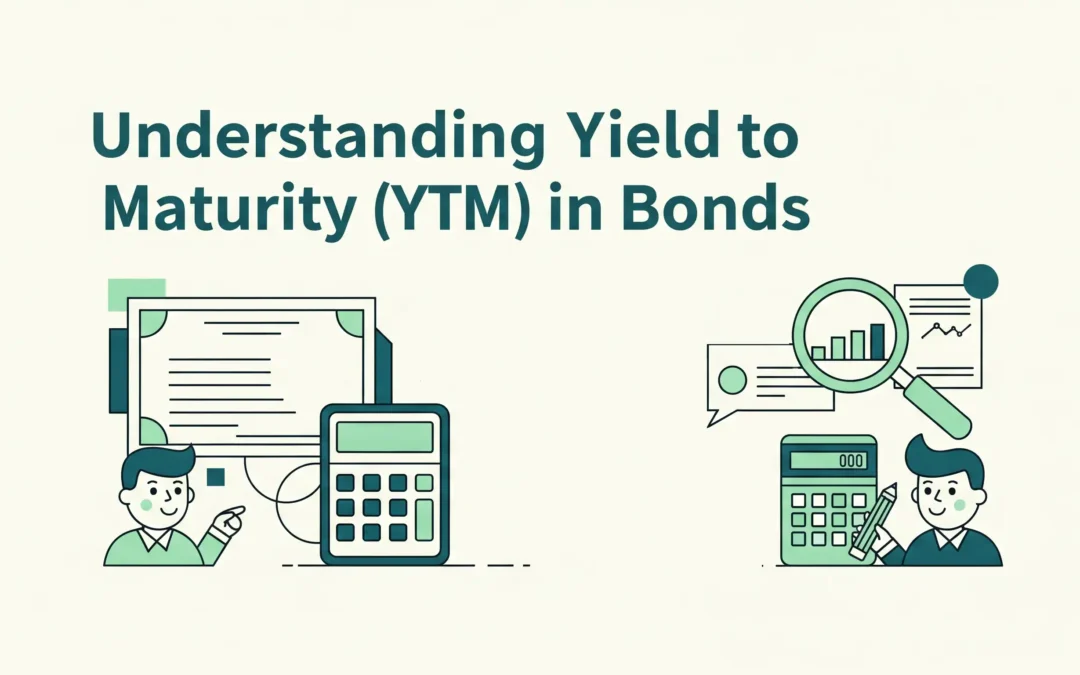Before investing in a bond, there are various factors that investors may consider. Yield to Maturity or YTM is one such factor that shows the total expected returns that the investor may receive if the bond is held till maturity. It is calculated based on the bond’s coupon payments, face value, current market price, and the time remaining until maturity.
This article will give a detailed insight into YTM, its features, pros, and cons associated with it, and finally, how it is calculated.
What Is Yield to Maturity (YTM)?
The total expected return on a bond if it is held until its maturity date is known as the yield to maturity, or YTM. It considers any gain or loss if the bond was purchased at a price lower than its face value, in addition to the interest payments, also known as coupons.
Key Features
- Represented as a yearly percentage return.
- It is assumed that the bond will be held till maturity.
- Takes final principal repayment and coupon payments into account.
- Assumes that the YTM rate of reinvested coupons is the same for all coupons.
- It shows the actual return, taking into account not only the coupon but also the market price.
How is YTM Calculated?
The bond’s current market price is used to compute YTM, which is the interest rate that makes the present value of all future cash flows (principal and coupon payments) equal to the current price of the bond. An approximate formula for YTM is:
YTM ≈ [C + (F – P) / N] ÷ [(F + P) / 2]
This gives a quick estimate, but actual YTM is found by solving the internal rate of return (IRR) of all future cash flows.
- C is the annual coupon payment.
- F is the Bond’s face value
- P is the current market price.
- N is the number of years until maturity.
Example:
Bond Details Value
Face Value (F) Rs. 1,000
Annual Coupon Rate 8%
Market Price (P) Rs. 950
Years to Maturity (N) 5
Annual Coupon Payment (C) Rs. 80
YTM ≈ [80 + (1000 – 950) / 5] ÷ [(1000 + 950) / 2]
= [80 + 10] ÷ 975 = 90 ÷ 975 = 0.0923 or 9.23%
The bond was purchased at a discount, so even though the coupon rate is 8%, the YTM is 9.23%, which provides you with better returns overall.
Why YTM Matters to Investors?
Let us see why yield to maturity is important for investors:
Displays the Whole Return, Not Just Interest
Coupon payments and any profit or loss from purchasing the bond at a premium or discount are included in YTM. Because of this, it is more accurate than merely examining the stated interest rate.
Facilitates Bond Comparison
It enables you to compare bonds using a common metric, regardless of price or maturity. This aids in selecting the most lucrative choice among bonds with comparable appearances.
Beneficial for Long-Term Planning
We now know that the bond has to be held till maturity to get returns, represented by YTM. Because of this, it’s perfect for matching investments to long-term objectives like retirement or education.
Indicates Risk and Gain
A higher YTM may indicate higher risk, such as a lower credit rating or greater market uncertainty, but it is not a guaranteed rule. You should always examine the creditworthiness of the bond issuer and other risks before concluding that a higher yield means a better investment.
Assists You in Choosing Interest Rates
YTM helps you understand the expected return if you purchase the bond at its current price, under current market conditions. However, it does not predict future changes in interest rates. However, it does not predict future changes in interest rates, nor does it guarantee that today’s yield will remain unchanged. It is a static measure, not a forecast.
Limitations of Yield to Maturity You Should Know
Looking at the downsides is equally important to understanding the clear picture. Let us look at them:
- Assumes a constant rate of reinvestment
It is assumed that all the coupon payments that are received during the bond’s life are reinvested at the same YTM rate for the calculations. Your actual returns won’t meet your expectations if future rates are less than the YTM. - Disregard Default and Credit Risk
At maturity, YTM assumes that the bond issuer will fully repay the principal and pay all interest. For high-yield or lower-rated bonds with a genuine default risk, this presumption is not true. In these situations, YTM may overestimate the return. - Callable Bonds are inaccurate
YTM may not reflect the actual return for callable bonds because the issuer can repay the bond early. In such cases, investors should also calculate the Yield to Call (YTC), which assumes the bond is called at the earliest possible date. - Is Not Inflation Adjusted
Since YTM is a nominal return, inflation is not taken into consideration. The real value of the returns (purchasing power) falls if inflation increases dramatically. Investors may overestimate the amount of value they are actually gaining over time if they only use YTM. - Assumes Holding Until Maturity
Only if the investor keeps the bond until its maturity date does YTM apply. However, because of rebalancing their portfolios, interest rate fluctuations, or liquidity requirements, many investors sell bonds before they mature. Actual returns in these situations might be very different from the YTM.
Bottomline
YTM is a valuable tool for investors because it considers both interest and any gain or loss due to the bond’s price, not just the coupon. It is especially relevant for long-term investors who plan to hold the bond to maturity. However, YTM’s calculated return depends on holding the bond until maturity and reinvesting coupons at the same rate, which may not reflect reality. It also does not factor in the risk of default or early call by the issuer, nor does it account for inflation, which can erode your real returns. Always consider these limitations and perform additional risk and credit analysis before making investment decisions based on YTM alone.


